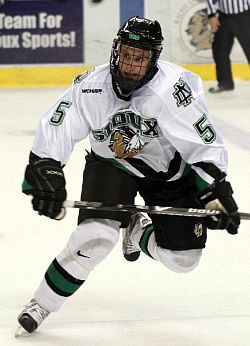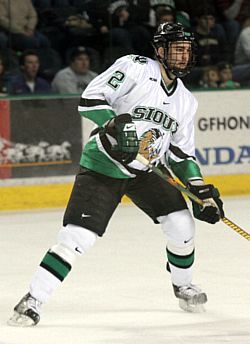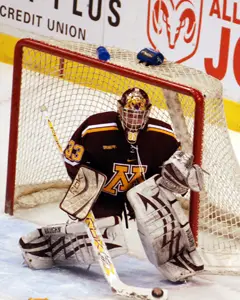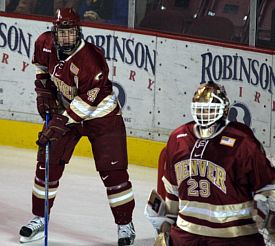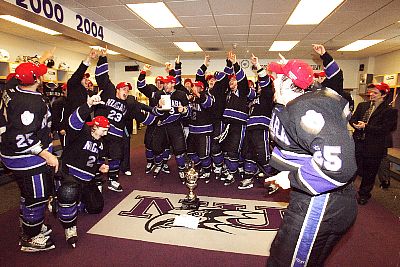So here we are.
The final ECAC Hockey weekend of the year, and it appears that only one of these teams will join Clarkson in representing the league in the NCAA tournament. Where it once seemed as though Harvard or maybe even Princeton could sneak in without winning the whole shebang, resident PairWise swami Jayson Moy has gone and told us that it’s probably not in the cards.
So who’s it going to be, then? Perennial titleholders Harvard or Cornell? Ivy competition and season’s surprise Princeton? Or could upstart Colgate ride Mark Dekanich and Tyler Burton all the way to the NCAAs from their No. 8 seed?
If you don’t have tickets yet, go get ’em … and if you can’t do that, tune in Friday on Time Warner, the NHL Network (both live broadcasts), or SNY (tape-delayed). Saturday’s coverage will be shown live on Time Warner, SNY and CN8, and delayed on the NHL Network.
Without further ado, here are the rundowns. (Side note: given the disparity in non-conference schedules, all statistics given are for league games only unless otherwise noted.)
No. 2 Princeton
Background: It’s tough for most fans and pundits to believe in the Tigers after so many years of futility, but ask any coach or player around the league, and they’ll tell you that the Roar is for real.
Princeton got out to a quick start, beating Yale (in a non-conference game), Cornell and Colgate in its first three games of the year. The team then suffered four- and three-game losing skids before the winter break, but rediscovered its game around New Year’s with a six-game winning streak. Including that tear, the Tigers have finished 14-5-0 and only lost consecutive games once, at Clarkson and St. Lawrence to finish the regular season.
Goaltending: As with the rest of the field, Princeton’s answer in goal has been singular all season long. Zane Kalemba’s 13-6-0 record is his most important statistic, as his other numbers aren’t terribly representative of his skill.
Head coach Guy Gadowsky isn’t concerned by Kalemba’s 2.43 goals-against average or .913 save percentage. The fourth-year coach has praised the sophomore for his unshakable composure in tight games and his ability to focus best when the chips are down. At the very least, the results have borne out the fact that Gadowsky does indeed have great confidence in his goalie, as Kalemba has only been replaced once all year, in a 4-3 loss at Union on February 1.
Kalemba plays a hybrid style to match his average 5-foot-11 frame. While he’s not the biggest goaltender in the league, he’s certainly not the smallest, and his methods aren’t particularly outstanding or noteworthy. He simply plays the angles well, doesn’t stray far from the crease, and demonstrates cool athleticism in the face of chaos.
Defense: The Princeton defensive corps pretty much lives or dies on the strength and leadership of senior captain Mike Moore. Fortunately for those in Tigertown, Moore has been the epitome of dependability on the blue line this year, playing in 31 of 32 games thus far — as many as any other Princeton player.
Sophomores Jody Pederson and Brad Schroeder have also played 31 and 30 games, respectively, and freshmen Taylor Fedun and Matt Godlewski each skated in 29. Suffice to say, the Tigers have been extremely fortunate to get both solid and consistent play out of their young defensemen. Even sixth defensemen Cam Ritchie and Kevin Crane have combined for 39 games between them.
As a unit, the D has allowed just shy of 28 shots a game, both in-league and overall, and only four regular players (at least 20 games played) have negative +/- ratings. The Tigers surrendered 57 league goals, or about 2.6 a game, to finish fifth in team defense. However, only Cornell (14) allowed fewer third-period goals than the Stripes (19).
Special Teams: Princeton earned the third-most power plays in the league this year with 109, and finished fourth in efficiency at 18.3 percent. Junior Brett Wilson led the team in power-play goals with five, but three other players had three each.
Gadowsky’s approach is no-fuss, no-muss: get the puck into the zone, put it on net, and crash hard for a rebound. So maybe it’s all about the fuss and muss, but for the opposition. The Tigers attempt as many shots on the advantage as anyone else in the league.
Princeton finished around the middle of the league on the PK, stymieing the foe on 84.4 percent of his chances. Finishing the season fourth-best in the ECAC with only a dozen penalty minutes a game doesn’t hurt, either.
Offense: Player of the Year Lee Jubinville led the Tiger attack with 10 goals and 21 assists this season, but it was the aforementioned Wilson who actually topped the team in goal-scoring with 13. Rookie Mike Kramer potted eight of his own, and sophomore Cam MacIntyre and Moore helped out with 15 and 12 assists, respectively.
Gadowsky likes offense. He encourages a wide-open game with quick attacks and lots of skating, and his players love him for it. The Tigers scored nearly three and a half goals a game, leading the league in offense. The scoring-by-period breakdown indicates an ability to wear opponents down, as the Garden State skaters notched 20 first-period goals, 25 in the second, and 30 in the third this year.
In a nutshell: Be prepared to skate hard, weather a lot of shots, and escape some excellent forechecking and defensive-zone pressure if you want to beat the ‘Cats. They don’t take many penalties, so a clean but physical game is important. Keep the play to the corners and the periphery, try to beat Kalemba earlier rather than later, and always keep your eyes on nos. 6 and 16.
No. 3 Harvard
Background: The Crimson, too, started the 2007-08 campaign on a hot streak, winning four of their first five games — all in league — and only stumbling twice in their first six, with 2-1 losses to Clarkson and Colgate.
However, Thanksgiving gave Harvard nothing to be thankful for, as the Cantabs tied Yale and beat Dartmouth immediately following the holiday, but then suffered Severe Tire Damage in a nine-game winless stretch. The offense died and the defense died with it, scoring fewer than two a game but allowing three and a half over the duration of the spin-out.
But the Harvard icers recovered, finishing the year 8-2-1 following January 12th’s 4-2 loss to Clarkson, and took a six-game unbeaten streak (5-0-1) into the playoffs. The Crimson promptly beat the tar out of Quinnipiac and QU’s entire extended family in an 11-0 Game 1 blowout, before back-sliding in a 7-4 loss the following night. The hosts bounced back with clean, hard-nosed play in the deciding match, and advance to take on hated Cornell in the semis.
Goaltending: Kyle Richter won the Dryden Award this year, playing stellar hockey at a consistent level all year long. The sophomore leads ECAC Hockey in goals-against average (1.82) and save percentage (.935), with Cornell’s Ben Scrivens in second place in each, and Colgate’s Mark Dekanich in third, as a matter of fact.
In 32 appearances, Richter has also only been relieved once, after six of Boston College’s seven goals in early December’s 7-2 loss. In league play, he had more shutouts (three) than four-plus goals-against games (two), and he also cobbled together four- and three-game streaks in which he allowed one goal or less each game.
His rebound control is better than average, but still imperfect, and Richter constantly fights the urge to retreat deep into his crease. Goal coach Bruce Irving (Cornell ’85) likes what he sees in the young ‘keeper, and compares him to Harvard’s great Hobey finalist, Walter Brown Award-winner and All-American Dov Grumet-Morris.
Defense: Sophomores Alex Biega and Ian Tallett have come on strong this year, leading the rearguard in +/-. The well-known Biega played in all 32 games this year, and with three goals and 17 assists, even beat his freshman brother Michael in scoring. (The younger Biega led the team’s rookie class with nine goals and seven assists in the full complement of games.)
Tallett, however, is the big surprise in back. The 6-foot-2 product of St. Louis, Mo. has played in pretty much every game since December, after only making two cameo appearances in all of last year. Tallett’s sharp performances bumped highly regarded recruit Chris Huxley out of a regular starting job, and Tallett currently boasts the second-best +/- on the team, with a +13 in 21 games.
Upperclassmen Dave Watters, Brian McCafferty and Dave MacDonald have played well down the stretch, including Watters’ career-high five-point night (hat trick included) in the first playoff game against the Bobcats. Sophomore Chad Morin and junior Jack Christian make Ted Donato’s defense incredibly deep; it’s a smart, quick, fast group of players who aren’t afraid to make a little contact either, unlike some Harvard teams of the past.
In case there was any doubt, the Crimson finished atop the league with 1.86 goals allowed per game.
Special Teams: If Donato has any complaints about his team this season, it’s about untimely penalties. The Crimson are among the league’s cleanest, but bouts of undisciplined play have plagued the team all year long, including in Saturday’s quarterfinal loss.
The power play is clicking along at 20 percent, good for third, but Harvard has only drawn 90 advantages — fewest in the league. (By comparison, St. Lawrence drew 117 power plays.) Sophomore Doug Rogers has been big on the PP with four of the squad’s 18 goals, while Michael Biega scored three.
As evidence of the penalty problem, Harvard not only has the worst difference between power play opportunities and penalty kills of the remaining quartet; they have a negative difference: 103 times this year on the kill, to only 90 on the advantage.
Fortunately, the Crimson PK was the best in the league with a 91.3 percent success rate, not to mention four shorthanded goals.
Offense: Harvard’s scoring has been evenly balanced, with four six-goal scorers and one with eight (sophomore Doug Rogers). Senior Mike Taylor has had a breakout campaign with 19 league points and 32 overall, following last year’s 21-point overall production. Sophomore Jon Pelle and McCafferty each boast 10 assists, and seven different Crimson (including two defenders) tallied double-digit scoring on the league tables.
Harvard’s attack is quicker and less physically imposing than some others around the league, as the forwards prefer to swarm and pounce, rather than simply pounding pucks on net and grappling for rebounds. They can be held at bay by a good skating blue line with good vision, and the whole operation can be thrown off with quick and lethal counter-attacks.
That said, this is a tricky bunch. They can create odd-man rushes out of thin air, and are excellent at finding the open man on the back-side doorstep.
In a nutshell: Harvard finished the regular season as one of the hottest teams in the country, and Quinnipiac really didn’t do much to slow them down. The Crimson capitalize on inadequate goaltending and slow-footed defense, and Richter is good enough to bail them out most of the time.
However, the offense is built for the quick strikes, not the protracted territorial battles. Harvard has been known to queue up for the penalty box at times, and when the defense gets sloppy, the opportunities on net tend to have a snowballing effect.
Beat the Crimson in the slots and down the center of the ice. Frustrate their hotheads (Jimmy Fraser and Morin each topped 40 PIM this season), and win the turnover battle.
No. 5 Cornell
Background: The Big Red began the season in inauspicious fashion, dropping the regular-season opener to RIT before rolling out to a 4-2-0 start in ECAC play. They then went 2-2-2 in non-conference games to straddle New Year’s, and have effectively played .500 hockey the rest of the way: 8-7-1 against the league in 2008.
A Game 2 loss to Dartmouth at Lynah put a bit of a scare into the Red, especially after having beaten the Big Green 6-0 the previous weekend and 3-2 the evening before. The Ithacans came on strong in the decisive third match, however, burying the Green 6-0 once more.
Scrivens and the Red then outlasted home-standing Union in the quarters, beating the Dutchmen 3-2 on consecutive nights. Both game-winning goals came in the third period to break 2-2 ties, and Scrivens stopped 41 shots on Saturday to advance to Albany.
Goaltending: As previously mentioned, Scrivens finished second in the league to Richter in both GAA and SvP. Facing roughly 28 shots a game, Scrivens has two three- and four-game stretches and one six-game period in which he allowed fewer than three goals in any game. He’s 8-2-1 following a loss, the best of any starter in the league.
At 6-foot-2, 180 pounds, Scrivens is a big guy who plays like a big guy. He has a strong awareness for his angles, and isn’t flustered by proximity action. The only major knock against him right now is his lack of experience and average reflex time to the top corners.
Defense: It’s never a bad thing when you have four defensemen with at least 33 games played (of 34 total team games) in a season.
Representing all four classes are senior Doug Krantz, junior Jared Seminoff, soph Justin Krueger and rookie Mike Devin. The scoring actually arranged itself inversely therein, as Devin’s three goals and seven helpers led the corps. Brendon Nash (15 overall points), Taylor Davenport and Jordan Berk each laced up for more than 20 games this year as well.
The Cornell blue line is big and rough. Coach Mike Schafer has been preaching physical play since day one, and the team has responded with exhausting pressure and a style that discourages center-ice shenanigans. In the second year of a rebuilding phase, the Red look poised once again to pound the league senseless.
Special Teams: The Red finished second in the league with both a 21.7 percent efficiency rate on the power play and a 87.6 percent kill. Freshman Riley Nash gave opponents fits this year, scoring five of his eight goals this year on the power play. Second-year standout Colin Greening scored four of 12 on the advantage as well, and five other players had at least a couple goals on the PP unit.
Cornell’s offense was more dependent on its power play than any other in the league, as the Red scored more than 38 percent of their goals on the advantage.
When shorthanded, Schafer’s troops have been outstanding, allowing only 12 goals in 97 chances. The unit is adept at clogging lanes and playing an aggressive box-defense, but without overextending itself or running itself ragged chasing passes. If there’s anything at all that the PK could do better, it might actually be to take a chance every now and again: Cornell is one of only two teams — Union being the other — without a shorthanded goal this year.
And honestly, how much of a detriment is it to have an uncompromisingly conservative penalty kill?
Offense: The Big Red finished fifth with 2.73 goals per game, but got big production from the younger crowd.
Greening led the team with 12 goals and 22 points, but Nash had a dozen assists and 20 points of his own. Third and fourth on the list were seniors Topher Scott (7-11-18) and Raymond Sawada (4-9-13), followed by a quartet of players who barely hit the double-digit mark.
The scoring has been coming a little bit easier for Cornell of late, as the team has been held under three goals only twice in its last 10 games. (In the same time, the Red have scored six goals twice, and pinned on the PAT for seven against Rensselaer on February 16.) Greening, Nash, Sawada, Patrick Kennedy, Blake Gallagher and others have chipped in recently, so it’s anything but a one-man show.
In a nutshell: Don’t take penalties, and you won’t have to stop the Big Red power-play machine. Cut out the power play, and you’ve saved yourself a lot of grief against this team. Schafer prefers to see his team winning on the walls and in the corners, and if you can break a play or two up the middle, it has a good chance of splitting the D.
Make Scrivens move laterally, and put the puck high: he’ll scoop up anything and everything that’s fewer than 12 inches off the ice. Ultimately, to hang with the Red requires patience and quick passing with few mistakes. Keep them skating, instead of hitting.
No. 8 Colgate
Background: In looking at Colgate’s results this year, there just don’t appear to be all that many Ws on the screen. Of course, playing 40 games can skew things a bit.
The Raiders didn’t get a league win until game number six — their final point-game of 2007, thanks to a spring-heavy schedule. Once ’08 rolled around, however, things started to fall into place for coach Don Vaughan’s program. The ‘Gate enjoyed three winning weekends to two losing ones, and only lost consecutive games once, in the home-and-home with Cornell that opened February.
The Raiders lost the opening games of each playoff series, and both against the North Country teams. In Round 1, St. Lawrence chased the usually stalwart Dekanich late in the second period of the first game. “Dex” came back strong though, allowing only three goals on the next 65 shots to shut down the Saints.
Then came the upset. After dropping the first game of the quarterfinals 1-0 (Dekanich faced 26 shots in the defensive affair), ‘Gate scored a veritable bushel of goals in Game 2, a 4-3 win. The rubber match was a doozey, as Clarkson scored shorthanded to open the game, and Colgate replied with a double-salvo in the second for a 2-1 lead. Clarkson drew even in the third, but Dex stood tall in stopping 18 of 19 shots in the frame (and 38 of 40 in regulation).
Overtime saw another 14 shots come Dekanich’s way, while Colgate finished the game with the comparatively meager total of 32 total shots on goal. But it was David McIntyre’s goal 7:36 into the second extra session that kept Colgate’s season alive.
Goaltending: Mark Dekanich is, nationally, the best goalie that no one’s ever heard of. He played in 39 of the Raiders’ 40 games, and stopped over a thousand shots for the first time in his career. (He faced over 1,000 shots in three of his four seasons, but this is the most so far.)
Dekanich’s six shutouts beat his sophomore four, and tie him for the most in the country overall. He’s also 13th nationally in GAA, ninth in save percentage, and third in minutes played. Given his workload, experience and polished style, he’s doubtlessly going to have the Nashville Predators’ full attention upon graduation.
Defense: First the bad news. Junior Nick St. Pierre is out for the season, which is a big blow to a light-scoring defensive team such as Colgate. A top-four defensive team, ‘Gate got the full 40 from senior Matt Torti and freshman Kevin McNamara.
Freshman Wade Poplawski and juniors Jason Fredricks and Mark Anderson each fell in the 35-40 GP range, while St. Pierre and third-year player David Sloane appeared in 32 and 30 games, respectively.
Oddly enough, the Raiders aren’t afraid to involve their defenders in the attacking scheme, as the squad got more than 20 percent of its goals (12 of 58) from the rear. Anderson’s four goals led the group, and he also finished second on the team in overall +/- with a +16.
Special Teams: Colgate finished around the middle of the pack with 13.2 penalty minutes per game, but the power play was abysmal, and the penalty kill sub-par.
The PP’s 11.1 percent success rate was better only than RPI’s incomprehensibly bad 7.6. Burton, Jesse Winchester and McIntyre were the only players to score more than once on the advantage all year long, with four goals, two, and two, respectively. Once again, only the woeful Engineers scored a smaller portion of their goals on the PP than the Raiders.
With a man in the box, Colgate trundled along at an 82 percent kill rate, only good enough for eighth in the league. Fortunately, despite the average number of penalties taken, there were enough in the form of matching minors and such that the Raiders had to kill the third-fewest penalties (95) in the ECAC.
Offense: Tyler Burton. Jesse Winchester. David McIntyre. Stifle them, and you’ll probably go home happy. Lose sight of one of them, and your goalie won’t like you very much.
Senior center Burton finished with 13 league goals, five more than anyone else on the team. Winchester had a hand in a lot of those though, with 15 assists, as the classmates tied for the team lead at 20 points. Sophomore McIntyre’s eight goals and eight assists make him a balanced threat, but after that it’s mostly a list of players who have been happy to tag their names to someone else’s goals — Burton, Winchester and the Mac account for 26 of Colgate’s 58 league goals this season.
That being said, the Raiders ended up in the middle of the scoring pack, potting a reasonable 2.64 goals per game. Harvard only scored one more goal than the Raiders this season, in fact. The issue is more with the consistency of the scoring, rather than its season-ending total.
The Hamilton icers put up a three-spot or better in eight of 12 to this point, but also endured four- and six-game droughts of two goals or fewer. The ‘Gate skaters couldn’t even get Dekanich a win in a shutout on February 9, which ended in a 0-0 draw at Clarkson.
In a nutshell: Keep a hard eye on those top three scorers, and don’t be afraid to bully them a bit — what’s the power play going to do, should it come to that? Waste time? Dekanich is superb but human. Don’t expect any easy goals, and for that matter don’t expect too many hard ones either. Scoring will come from hard work and being in the right place at the right time, e.g. cross-ice feeds, the occasional uncontrollable rebound and scrambles in front.
It’s a top-heavy team on offense, so take full advantage of the second change. If they’re gonna beat you, I’d bet heavy on the Big Three doing you in.
